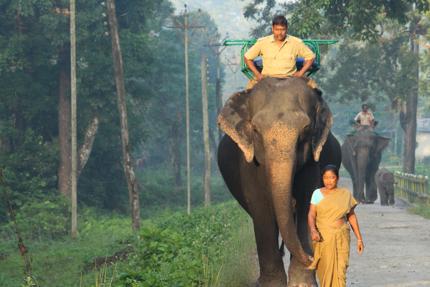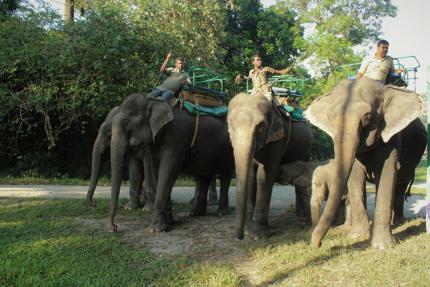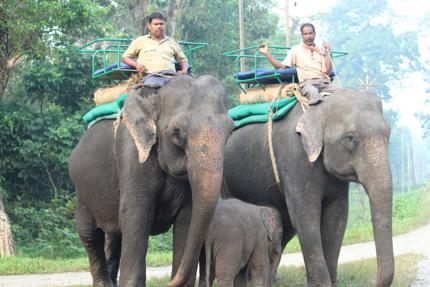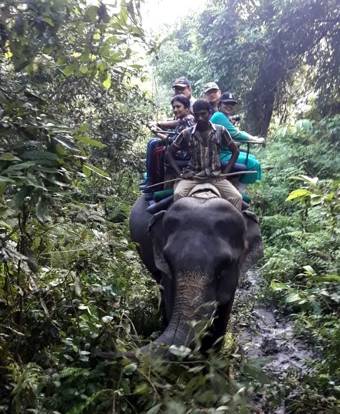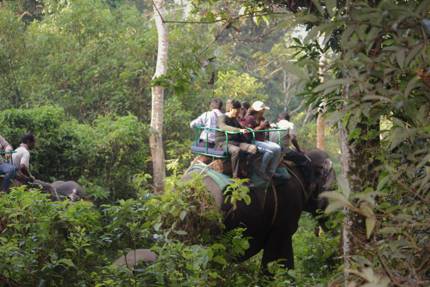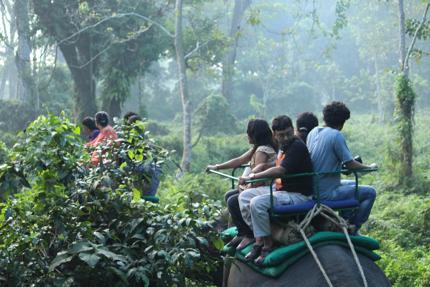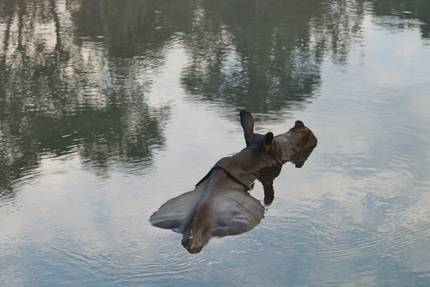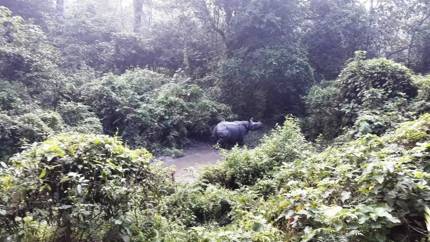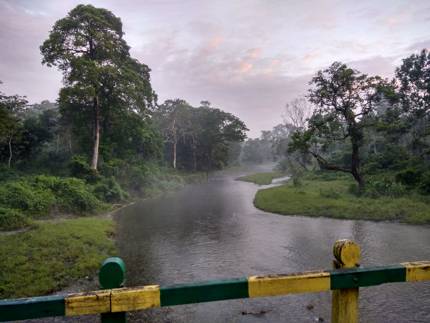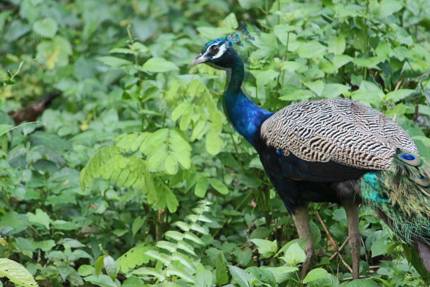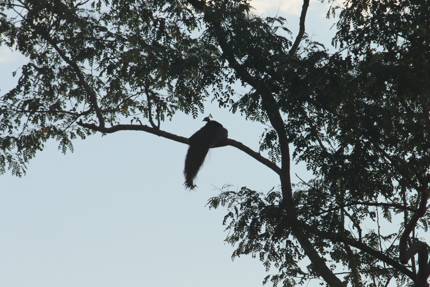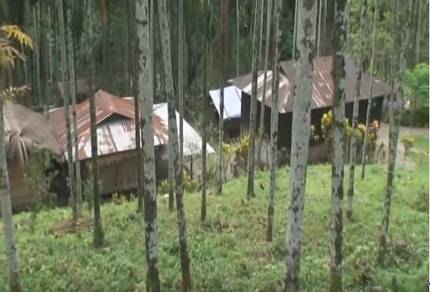Jaldapara National Park: Elephant & Jeep Safaris
About Jaldapara National Park
Jaldapara is one of the largest national parks in the whole of dooars and spans an area of 216.51 square kilometers. It's located at the flood plains of river Torsha at the foothills of eastern Himalayas in Alipurduar District. However several other rivers including Malangi, Hollong, Chirakhawa, Kalijhora, Sissamara, Bhaluka, Buri Torsha too flow through the forested areas of Jaldapara.
Actually Jaldapara National Park is the forest on the western bank of river Torsha while Chilapata forest is on the eastern bank. The river Torsha divides the forests here into two parts. Madarihat is the closest township and the local guides can sometimes mislead you when they talk about safaris in the jungles here - unles you get your understanding correct, you might be on a safari to Chilapat instead of Jaldapara National Park as they both are close by and wildlife sighting is similar.
Just for your information, Jaladapara was first declared as a sanctuary in 1941 and subsequently in 2012 it became a national park. Although few decades back it had far more prominence than even Gorumara because of its many unique features such as elephant safaris (apart from Jeep safaris), much larger coverage area and even resident tigers (although seldom seen nowadays), Gorumara has leapfrogged in its stature and popularity over the years and has gone on to become a model national park in the whole of India, mostly because of its eco-friendly and eco-tourism approach.
The jungles of Jaldapara comprises of vast stretches of grassy land (many parts with dense elephant grass which can even be taller than human beings), swamps & muddy lands, and dense forests of tall trees such as Sal, Sishu, Khair etc all interspersed with each other. In fact more than 30% of the forest is covered with thick grassland and swamps.
So what wildlife can you spot at the forests here? Plenty... to say the least. One of the key attractions here is the Asiatic One-Horned Rhinos. And you can see them while on an elephant or a jeep safari and even from a watchtower. One-horned rhinos are pride of India and Jaldapara is home to highest number of such rhinos in the whole of the state of west Bengal. In fact the population of such rhinos in Jaldapara is 2nd highest in the country after Kaziranga forest in Assam. However the problem of wildlife poaching that Assam suffers, does not exist in Jaldapara and therefore the number of such rhinos here are steadily in the increase and has already reached a number close to 200.
There are many more exotic animals in the jungles here other than rhinos. Elephant sighting too is quite common and they can be often found wandering around on grassy land or by the banks of the rivers. Bisons (also known as Gaurs) can also be sighted quite easily during early mornings and late afternoons when the heat of the sun is comparatively less. Locals say that Bisons can be even more dangerous than wild elephants although they apparently look docile.
And you can find large number of deers of different types here including Chital & Sambars (which can be usually seen in groups or families), Hog Deer which are usually solitary in nature, and Barking Deers which are small in size and known to be producing loud sounds like that of a barking dog.
Tigers and leopards also exist in the forests here although you need to be lucky to spot them. Other wild animals here includes wild boars, smaller cats such as jungle cats, fishing cats etc, civets, giant squirrels, hispid hairs, porcupines, pangolins and even venomous snakes such as pythons & cobras.
But there is lot more for the naturalists and for those who love birds.... there are plethora of birds in Jaldapara, well over 240 types of birds have been spotted here. So if bird watching is your hobby, then Jaldapara must be in your target list. The grasslands, shrubs, swamps and forests here create a perfect combination for different species of birds to make it their home.
Some birds which can be commonly spotted are Cormorant, Shag, Darter, Egret, Pied Wagtail, River Lapwing, Moorhen, White Breasted Waterhen etc. Others includes Green Pigeons, Hornbills, Barbets, Parakeets, Woodpeckers, Cuckoos, Orioles, Drongos, Babblers, Thrushes etc. During winter time you can see Brahminy ducks, Whistling Teals and even Merganser.
Some of the common birds of prey that you can find here are Crested Serpent Eagle, Pallas’s Fishing Eagle, Pied Harrier, Common Buzzard, Kestrel, Sparrow Hawk etc. The grassland birds can be best seen from the watch towers and they include Doves, Bee-eaters, Rollers, Hoopoe, Shrikes, Larks, Hill Mynas, Bulbuls, Finches etc. Peacocks and Peafowls can also be seen easily while on safari.
Jaldapara Elephant Safari
Elephant safari in Jaldapara takes place in the morning hours and starts at the Hollong Lodge of WBFDC (West Bengal Forest Development Corporation). These safaris are operated by the staff of Forest Department on trained elephants. There are presently four such elephants - Laxmi, Minakshi, Madhumala and Priyadarshini, and all four usually participate in the safari.
While you can see various wildlife during elephant safari, the main objective is to spot the one-horned rhinos. From the main entry to the forest at National Highway, the Hollong Lodge is about 7kms inside the forest. You can take your own vehicle up to the lodge to take the safari, or it can be packaged into the fees whereby you need to pay extra for pick up and drop at your hotel.
We took the first ride early in the morning and reached the Hollong Lodge on our own vehicle. You need to start at least one hour before the ride time as there are some entry formalities that needs to be completed at the main gate on national highway at Madarihat.
Elephants arriving for the safari
Once you reach the lodge gate, there is a riding platform with few steps to climb. Elephants would come and stand next to the elevated platform so that you can take a seat on its back. Four persons can sit on each elephant, two on each side facing opposite directions. Your legs will hang and there is a railing that you need to latch on to. I could not understand the significance of the railings until the bumpy ride actually started and the initial part of my ride was all about keeping my balance.
Elephants lined up and ready for the rides
When we reached, there were no elephants yet. We were told that since this was the first trip of the morning, they were getting ready and the mahouts were fixing the seats, they would soon arrive. Meanwhile we were asked to get into the lodge premises and try to spot some wild animals.
Right across the lodge there is a walkway through a beautiful garden and at the end was a viewing area with benches around. Ahead was a wide trench and then there was a large grassy land with a saltlick surrounded by dense forest. Saltlick attracts wildlife. What we saw was something unbelievable... a huge one-horned rhino right at the middle of the grassy land near the saltlick.
I was mesmerized with the sight and thanking god for such luck to start the day, and then a coarse voice behind me drew attention of all ... "Eh! It's the same one we saw right below our window last evening. Looks like this is a domesticated rhino trained to pose for tourists".
I could make out that the man was staying at Hollong Lodge itself and would have spotted the same or a similar rhino last evening from his room .... only a few lucky ones get accommodation in Hollong Lodge that gets booked months in advance and get to see such wildlife which most others can't. But demeaning a rare luck and a rare wildlife like this immediately prompted a co-tourist to say to the man "I think you are better off visiting a zoo and not waste a room in Hollong Lodge".
As expected... that statement immediately triggered an argument and then a commotion breaking the much needed silence for which you visit a national park and see wildlife in their natural habitat... the rhino was already walking back to the forest and soon disappeared into the jungle. I too decided to walk towards the elephant platform to check if the ride was now ready.
I was soon happy again. As I reached the riding platform just outside the lodge gate, I could notice the elephants with their mahouts at some distance away and they were marching towards us. What a wonderful sight! There were three large elephants and two cubs next to them. I was later told by our mahout that the elephants simply won't entertain the rides unless their cubs are with them.
Mahouts agreed for a photo shot (see the small cub)
We were on Priayadarshini and soon on our way to the forest. There are no marked trails as such as the elephants moved one after the other in a procession through dense jungles with large patches of marshy & grassy lands full of soft mud at places. We knew that it's a riverine forest... there would be many swampy & muddy lands as well as rivers crisscrossing the jungle.
On elephant safari at Jaldapara
But what I did not expect was the continuous uneven ride that was almost throwing me off-balance at times. I wondered if I fell down then my only fate could be to get crushed under the elephant's feet, if not by our own one then surely by the one following us. So I latched hard on to the railing with both hands... my feet hanging in the air and my camera from my shoulder.
Negotiating the dense forest
As I was trying hard to settle down with the odd rhythm of the ride, I felt we were suddenly falling into a deep ditch... actually the elephant was stepping through a muddy land down below into a river and perhaps itself was a little off-balance. The cub which was walking by the side, slipped with a loud thudding sound, half overturned and got stuck in the mud.
It took a while for our elephant and the one following us to use their trunks and help the cub recover. I looked at the mahout with bewildered eyes... he pacified me with a wide smile, assured me there was nothing to worry about, and said this acts a training for the cubs.
In the hunt for a rhino
Another difficult task was the numerous branches of trees that we had to continuously negotiate with our hands as the elephants moved through dense forests. All the mahouts were holding axe to cut off the hard branches along the way, but the soft ones were all on our face and body every now and then. I wouldn't have been surprised if a snake from a tree had fallen into our laps. Well, finally I was getting used to the journey. I was now getting confident of holding my camera with one hand, but clicking picture was not easy all along the safari.
At one point I noticed that the mahouts signaled something to each other and the elephants turned towards a large water body.... and there was a huge rhino half submerged in the water. Majestic sight! We wanted to halt there for some more time, but the mahouts won't risk it. An agitated rhino can attack as they said... although elephants together may be mightier, but such attacks can cause a lot of panic and may even result in accidents. So we moved along.
Rhino sub-merged in the waterbody
Having crossed another water stream we went deeper into the jungle. The elephants slowly made a semi-circle on a slightly elevated area overlooking a small grassy land below with a dense forest behind. A rhino again.... wonderful sight!! It was in the open wandering around but suddenly noticed us from below, turned back and started walking towards the forest, but not before I took a great picture.
Rhino at the open area walking back to the forest
Time to turn back and head towards the lodge. Along the way we once again crossed the streams, and this time the cubs became smarter to negotiate the descent through the mud efficiently and so did we. At one point the elephants dispersed in different directions but met again shortly.
We were soon crossing the grassy land with saltlick that we saw from the lawn of the lodge... there was then a rhino standing here when a tourist made an odd comment. But now it's an empty land and we could see from far tourists who had come for the next elephant ride, were curiously watching towards the saltlick trying to spot wildlife, instead we appeared from the jungle :)
How to book Elephant Safari
In case you land up at Jaldapara and then decide to take an elephant safari, then below are your options:
The guests of Hollong Lodge are given the preference because both the lodge and elephant safari are operated by the forest department. If you have booking at Hollong Lodge (which is not easy to get due to huge demand), you can book directly from the lodge itself.
Any remaining free slots are distributed to Madarihat Tourist Lodge (operated by West Bengal Tourism Development Corporation - WBTDCL) and other private hotels in Madarihat. So you need to request the hotel staff to book the elephant safari for your group. It can easily take 2-3 days to get a slot.
We were staying at Madarihat Tourist Lodge and the first thing on arrival we did was to contact the manager and requested for a booking of elephant safari for four of us. We booked rooms for three nights. While he took down the request, he repeatedly kept saying that it would be difficult to accommodate the request in 3-days time, but he would try his best. He showed us the long list of requests already pending and our bleak chances. Our chances were basically hinging on some earlier bookings getting canceled.
On repeated requests and perhaps through some extra friendly approach I could manage to get him work harder. He could finally secure a slot for us and that too on the day we were leaving Jaldapara. It was the first ride early in the morning and we were happy. The hotel takes an additional service charge, but in my opinion it's better to pay a service charge rather than taking all the hassles.
If your hotel is unable to book the safari, your last chance would be to contact the Assistant Wildlife Warden (your hotel can help with his phone number). He can help you directly talk to the forest department staff operating the elephant rides (i.e. the mahouts) and then fix up a slot for you on a day, if available.
Three Elephant Safaris take place everyday for one hour each and all in the morning:
5:30am to 6:30am
6:30am to 7:30am
7:30am to 8:30am
You need to start minimum one hour before your slot time to complete entry formalities and reach on time. It takes few minutes at the forest main entry gate on National Highway at Madarihat to complete entry formalities and then further 20 minutes by car to reach Hollong Lodge.
NOTE: Elephant Safaris do not operate on Thursdays. No safaris take place between 16th June to 15th September (monsoon season).
Elephant Safari Cost
Fare updated: March 2022
Rs. 1020/- per person
Vehicle charge for pick up and drop - Rs. 500.
Car Parking Charge - Extra
Service charge by hotel - extra.
Video of our Jaldapara Elephant Safari
The forest or tourism department do not directly operate any vehicles for Jeep safaris. There are few designated and privately operated open Gypsey vehicles that are used for Jeep safaris in Jaldapara National Park. Three safari trips take place every day - two in the morning and one in the afternoon: 5:30am to 7am; 7am to 8:30am; and 3:30pm to 5pm. So a safari duration is for 1 hour 30 minutes.
We were staying at Madarihat Tourist Lodge (of WBTDCL) and booked the afternoon Jeep Safari through the lodge. The main entry gate of the forest is at a short distance from the lodge and on the national highway (takes less than 5 minutes to reach). The vehicle picked us up at 3pm from the lodge.
Once the entry formalities were completed at the gate (by showing the payment receipts for entry fee, parking fee, guide fee, camera charge etc and making an entry into a register kept at the check post), we were on our way into the jungle. There were electrical fencing on both sides of the forest route. Along the way we crossed the Hollong river... an excellent place to spot wildlife on the river banks.
Hollong River
The Hollong Lodge (run by WBFDC) is about 7kms from the main entry gate. But we won't stop here now, instead passed by the lodge and veered right further into the jungle. Here the jungle is a dense forest of tall Sal trees and interspersed with elephant grass. At one point the guide asked the driver to stop... on the left was a large one-horned rhino in the forest!! Wonderful sight. Having satisfied our eyes and mind, we moved on. After a while the car stopped again... another rhino!
At another point along the way the car slowed down and the guide pointed his finger towards a group of bisons standing under the shades of trees. A peacock came from nowhere and crossed our route. At another place on a grassland there were two hog beers with their heads up and looking straight at us.
The peacock
Having driven about 7kms from the Hollong Lodge we reached the Jaldapara Watch Tower. Several other tourists had already reached the tower by then. We could spot a large group of sambars and then saw a rhino crossing the forest route and entering into the jungle. While we were engrossed in sighting the animals, there was a modern-life irritant that continuously haunted us - and that was mobile phones used by the tourists... many of them were more interested in talking to friends over phone than watching wildlife and the serene forests.
From Jaldapara Watchtower we moved on to Harindanga Watchtower. However having waited keenly for quite sometime, we were unable to make any animal sighting here. It was time to turn back and head towards the Hollong Lodge which too is a schedule stop in the safari. Here we were asked to enter the lodge premises and try to spot wildlife across the lawn on the other side of a trench.
We walked through the lovely lawn of the lodge with flowering gardens all around. At the end there was a concrete viewing area, then a trench to prevent animals from crossing over, and beyond the trench is a grassy area with a saltlick which is surrounded by dense forest. Animals come to the saltlick to take salt and also to feed on the healthy grass around.
But now we are watching an empty grassland with a saltlick. There was no animal to be seen. But we waited for a while. My brother took my attention to the top of a tree... a beautiful peacock sitting right on top of the tree and enjoying a panoramic view.
Peacock on top of the tree
Now I noticed there was something moving in the jungle behind the saltlick. I took up my binocular... I could spot a bison's head... it was looking at us trying to assess the situation silently before it makes a move. When it found everything was okay, it slowly appeared and walked towards the saltlick. And then another one followed.
Having thoroughly enjoyed the sight as I turned back, I saw a gentleman sitting on a bench nearby and deeply engaged in a phone conversation.... he was perhaps oblivious to the fact that there were bisons to be seen, or perhaps he was more interested in talking over the phone than watching wildlife.
How to book Jeep Safari
Almost all hotels in Madarihat (both Government and private) make arrangements of jeep safari against a service charge including the Madarihat Tourist Lodge of West Bengal Tourism Department. Of course Hollong Lodge located inside the jungle can also organize jeep safaris. If you want to book on your own, you can go down to the Madarihat market area and talk to the owners of the designated safari vehicles and fix up a safari. This way you can eliminate the hotel's service charge.
You can book car safaris for the following routes:
Madarihat Car Safari (Route: Madarihat NIC - Hollong Forest Rest House - Harindanga Watch Tower - Jaldapara Watch Tower - Khawcand Para - Back to Madarihat NIC)
Madarihat NIC to Titi/Toto Para (Route: Madarihat NIC - NH 31C - Torsa Bridge - Central Road - Lankapara FRH Back to NIC Madarihat via Central Road)
Chilapata Car Safari Route-I (Route: Chilapata Range Office - Shikari Line - Bania Watch Tower - Parl Road - Mendabari Watch Tower - Bania Ruins - Kurmai Forest Village - Back to Chilapata Range Office)
Chilapata Car Safari Route-II (Route: Kodal Basti - Heart Road - Mendabari Watch tower - Parl Road - Bania Watch Tower - Bania Ruins - Back to Kodal Basti)
Salkumar Gate Car Safari (Route: Salkumar Gate - Hollong Forest Rest House - Harindanga Watch Tower - Jaldapara Watch Tower - Salkumar Gate)
Note: NIC - Nature Interpretation Center
Division Office Phone No:7318933347
Centre in charge Mobile No:7318933347
NOTE: Jeep Safaris in Jaldapara do not operate on Thursdays. No safaris take place between 16th June to 15th September (monsoon season).
Jeep Safari Cost
(Fare updated: March 2022)
A jeep can accommodate up to 6 persons. You can book a full Jeep by paying for 6 persons and the full vehicle hiring charge, or alternatively join a group and pay a per person rate.
The Following fees/charges are to be paid by the visitor for Madarihat Car Safari
Visitor entry fee: Rs. 187/- per person (Rs. 500 for foreigner)
Vehicle entry fee - Rs.400 per vehicle.
Guide Charge - Rs.300 per vehicle.
Vehicle hiring Charges - Rs.1200 to 1500 per trip per vehicle depending on route length (The cost of jeep safari from Hollong Lodge is lesser than from Madarihar Lodge)
Entrance to Jaldapara Nantional Palk is on National Highway #317 in Madarihat area where most of the hotels are located. Although there is a small railway station at Madarihat, very few trains stop here. Hashimara railway station where several trains stop is only 11kms away and it takes only about 15 minutes by taxi to reach Jaldapara from Hashimara station.
The nearest airport is the Bagdogra Airport which is about 137kms away. You can take a pre-paid taxi there and reach Jaldapara in about 3 hours 15 minutes. From New Jalpaiguri (NJP) railway station the distance to Jaldapara is about 125kms and it takes close to 3-hours to reach by taxi.
Reserved small taxi fare from Bagdogra or NJP to Jaldapara (Madarihat) is Rs. 3,200/-. However this can vary depending on season and tourist demand. (Fare updated: March 2022).
There is also a bus service between NJP station and Coochbehar that goes through various locations in Dooars including Gorumara and Jaldapara. The bus leaves NJP at 8:30am, goes via Siliguri (Siliguri Tourism Centre) at 8:50am and reaches Jaldapara at 2:20pm. The return bus (i.e. the down service) from Coochbehar reaches Jaldapara at 11am and NJP at 5:10pm.
Read
How to reach Dooars for more details about routes, transport options and fares to reach various locations in Dooars including Gorumara National Park (Murti, Lataguri etc) and Jaldapara.
Although the national park opens from mid-September onwards, the best time to visit the park is during the winter time between November to March. There are several reasons for that.
Mid-September to October is the period just after monsoon has ended. While the forest looks green and serene, the trees and grasslands have grown during the monsoon with fresh leaves and the jungle is denser than ever. So animal sighting during this period may not be easy unless they come out in the open or you encounter them on a route through the jungle. There can also be occasional showers. But in winter the trees shed leaves, grasslands get thinner and weather is cool & perfect for jungle visits.
Having said that April to early June too is a good time. But it can become hot during summer and you need to be ready to sweat out a bit. Possibility of wildlife sighting is best early in the mornings and just before dusk when animals come out to the water bodies or river banks to drink water. During the day time when the heat picks up, they prefer to remain inside dense forests under the tree shades.
NOTE: Jaldapara National Park remains closed (for that matter all national parks and sanctuaries in Dooars remain closed) between June 16 - September 15 every year. This is the monsoon time and animal breeding season. So the safaris do not take place during this time.
While there are several private hotels in Madarihat which you can book through travel & tour agencies, there are two specific accommodations in Jaldapara that are targeted by most tourists.
The first one is the Hollong Lodge which is operated by the state forest department (WBFDC) and it has the highest demand. It is located deep inside the jungle and about 7kms from the main entry gate of the forest. Other than wonderful greenery and natural forest environment, the lodge also has a viewing area at one end of its lawn from where you can often see wildlife on a grassland at a distance which also has a saltlick to attract animals. You can book elephant and jeep safaris directly from the lodge.
Due to limited number of rooms in Hollong Lodge, it gets booked months in advance. You need to book the lodge through West Bengal Forest Development Corporation office located in Salt Lake, Kolkata.
The other lodge which too has high demand here is Madarihat Tourist Lodge operated by the state Tourism Department (WBTDCL). It has several kinds of rooms in the main building as well as nice cottages circling a sprawling lawn. Safaris can be booked from here as well. This lodge can be booked online through the WBTDCL website as well as through their BBD Bag office in Esplanade, Kolkata. Both Hollong and Madarihat Tourist Lodge are in budget category but offer nice clean accommodations.
Read
Best Budget & Upscale hotels in Dooars to detailed information about various lodges, hotels, resorts in Dooars including in Jaldapara that would suit your choice and pocket, and how to book.
Places to visit around Jaldapara
If you are planning for elephant and jeep safaris while in Jaldapara (which you should), you need to plan to stay for minimum 2-3 nights to make it possible because getting immediate booking of safaris is unlikely. However this also gives you ample opportunity for local sightseeing. In fact there are several very nice places to visit in and around Jaldapara which you can provision in your tour plan:
South Khairbari Leopard Rescue Center
The entry to South Khairbari forest is about 2kms from Madarihat Tourist Lodge. About 12kms inside the jungle there is a rescue center for tigers and leopards who need rehabilitation due to injury, ailment or aging. In fact this center was first established when use of tigers in circus was banned and several tigers from the circus groups were rescued and brought into the center for rehabilitation.
Once you reach you can walk, take a van rickshaw or a battery operated car to get around the center. You can see tigers and leopards from a close distance. They are kept in semi-natural habitats. The river Buri Torsha flows through the area here and you can even do boating. There is also childrens park here making it a nice place for families to enjoy. Read
South Khairbari Leopard Rescue Center for details.
Chilapata Forest Visit
Chilapata forest is located on the eastern bank of river Torsha and a jeep safari can be easily arranged from Madarihat (Jaldapara). The CCline watchtower is quite close to the river. The guided safari also takes you to Kodalbari forest and Mednabari watchtower. Elephant sighting is quite common here. Other than that you can spot wildlife such as one-horned rhinos, deer of different types including sambar, barking deer, spotted deer, hog deer etc, wild boars, bison and numerous types of birds including peafowls. Deep inside the forest exists the ruins of the fort built in 5th century by Nal King during the Gupta empire... it has a lot of historical and archeological significance.
Day trip to Totopara
Take a riverine road trip to Totopara which is a small village located 22kms from Madarihat (Jaldapara) at the Indo-Nepal border and under the lap of Himalayas. This is where the primitive tribal group known as Totos still live. Their numbers have been diminishing and has been reduced to less than 1000 now. Journey along the riverbed and then through lush greenery with views of the mountains is amazing.
Totopara
The aboriginal lifestyle of Totos and the picturesque village with backdrop of Kanchenjunga keep attracting a lot of tourists. As you drive along, you need to cross a tributary of Torsha river known as Hauri before entering Totopara. Betel nut cultivation is an important source of livelihood for Totos although they also depend on farming and keeping chickens, pigs, cows etc.
Kunjanagar Eco Park
This is a nice sprawling forested parkland located 19kms (45 minutes by car) from Madarihat (Jaldapara) and about 10kms from Falakata. There are marked trails through the park and you can reach a watch tower with a sweeping view all around. You can spot wildlife in the park including spotted deers, peacocks etc and sometimes although rarely even elephants, rhinos and leopards. River Torsha flows between Kunjanagar Eco Park and Jaldapara National Park. There is also facilities here for boating as well as family picnics.
Day trip to Phuentsholing
Phuentsholing is a bustling town of Bhutan and located at the Indo-Nepal border at a distance of 30kms from Jaldapara. You can easily reach by car in about 1 hour and there is no permit required for this. You can visit several wonderful sights here including a hilltop Gompa, Crocodile center, lovely park etc. There are several great shopping areas here and excellent restaurants to have sumptuous lunch. To know about all attractions, visit
Great places to visit in Phuentsholing
Day trip to Buxa, Jayanti and Chunia Watchtower
Buxa Tiger Reserve is around 40kms from Jaldapara (Madarihat) and takes little over an hour by car to reach (the entrance is at Rajabhatkhawa). From the entrance drive for about 15kms through the forest to reach a small village Santalabari. From here you can go further down to the foothill and take a 2.5kms uphill
trek to historic Buxa fort and even beyond.
A 5kms return drive from Santalabari takes to a diversion which leads to a small forest village Jayanti named after the river Jayanti flowing next to it. Walking on the riverbed is a wonderful experience with amazing views of Bhutan hills and forests around. There are small eateries here where you can take your lunch. You can also arrange for a jeep safari here through the villagers to take you to Chunia Forest on the opposite side of the river... water is shallow and you will drive across the river bed with Bhutan hills at the backdrop - the views are stunning.
Chunia Watchtower is located on the other side of Jayanti river and a great place for spotting several types of wildlife from the upper decks including elephants, wild boars, deers, peafowls and even leopards if you are lucky. NOTE: You may not have enough time to take a safari at Buxa Tiger Reserve though during the day trip (for that you need to stay overnight at Rajabhatkhawa).
Day trip to Sikiajhora
This is a small eco-tourism village located at the fringe of Buxa Tiger Reserve and about 47kms from Jaldapara (takes about 1 hour 15 minutes by car). The village is named after a stream which flows through Buxa reserve. Kalkut is a forest village located in the vicinity and is excellent for bird watching. There is a watchtower here. Sikiajhora and Kalkut are great places for nature lovers wanting to spend couple of hours in the lap of nature.
Related Articles
|
Visitors' Reviews/Comments
Sayani Ghosh (March 2022)
1. What is the last Jaldapara Jeep safari (4.00 - 5.30 pm ) reporting time ??
2. Is it possible to reach Jaldapara safari gate from Bagdogra within 3.00pm if we start at 12.30pm??
Raj (darjeeling-tourism.com) March 2022
The last Jaldapara Jeep Safari that takes place from Madarihat Gate to Hollong is from 4 pm to 5:30 pm. You should be reporting at Eco-Tourism Range, Madarihat (behind Madarihat Police Station) at least 30 minutes before the safari starts. Bagdogra airport to Jaldapara via Gajoldoba takes about 3 hours 15 minutes by car under normal traffic conditions.
|
